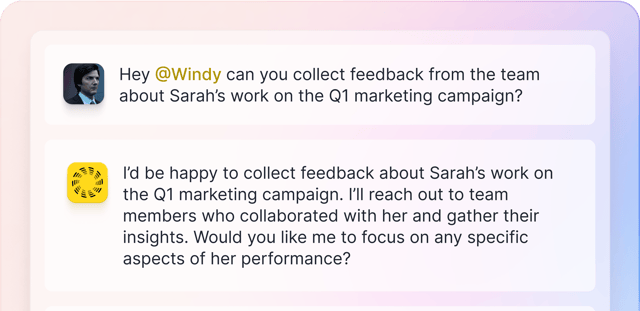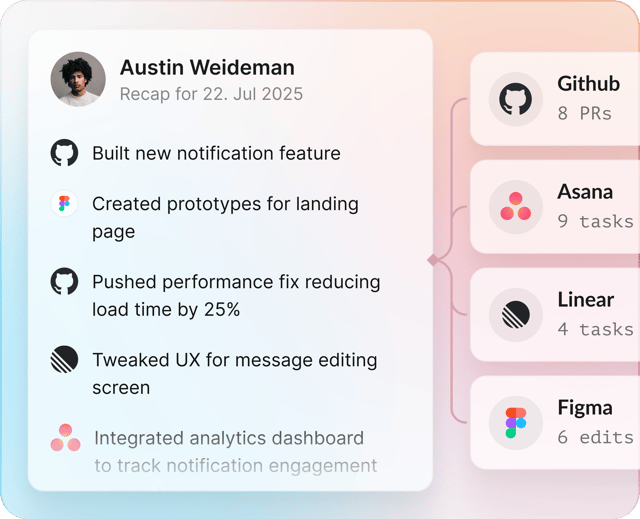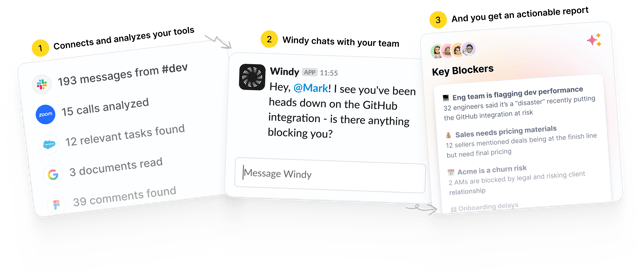Q3 Blockers Report - TechFlow Inc.
This is a report generated by Windy identifying critical blockers impacting team productivity and business goals. This was pulled from 5 employees and 4 integrations (Slack, GitHub, Jira, Linear).
- 🏗️ Infrastructure Overhaul: Migrate from legacy AWS setup to containerized deployment to resolve 30+ daily outages1.
- 👥 Hiring Acceleration: Fill 3 senior engineering positions and 1 DevOps role2 within 45 days to address understaffing.
- 📋 Process Standardization: Implement proper code review workflow3 and testing pipeline to reduce deployment conflicts.
- 💻 Dev Environment Fix: Upgrade development tooling and resolve Docker compatibility issues affecting 80% of team4.
✨ Executive Summary
-
Primary Blockers 🚫:
- 🔧 Technical Debt: Legacy infrastructure causing daily production issues5 and 4-hour average resolution times6. Development velocity down 40%7 due to environment setup issues.
- 🏃♂️ Resource Constraints: Critical understaffing in engineering (60% capacity8) and complete lack of dedicated DevOps support causing deployment bottlenecks.
- 🔄 Process Gaps: Inconsistent code review practices9 and manual deployment process leading to frequent rollbacks and conflicting releases.
-
Business Impact 📈:
- Customer Churn: 3 enterprise clients considering alternatives10 due to reliability issues
- Revenue Risk: $2.4M in pipeline deals delayed11 due to feature delivery slowdowns
- Team Morale: 70% of engineering team reporting burnout12 from firefighting operational issues
📝 Detailed Blockers Analysis
🏗️ Infrastructure and Technical Debt Crisis
The company’s infrastructure has become the single largest impediment to productivity. The legacy AWS setup, originally designed for a 5-person team, now struggles to support 15 engineers and 10,000+ active users.
Sarah Chen, Lead Backend Engineer described the situation: “Every morning starts with checking if production is down. We spend more time fighting fires than building features. Yesterday alone we had 6 separate outages, and I spent 3 hours just getting my local environment working again.”
Specific Infrastructure Issues:
- 📊 30+ daily production alerts13 requiring manual intervention
- ⏱️ Average incident resolution time: 4 hours14 (industry standard: 30 minutes)
- 🐌 Database queries running 300% slower15 than optimal due to outdated indexing
- 🔄 Deployment success rate: 60%16 (requiring multiple rollback attempts)
Mike Rodriguez, Senior DevOps Consultant noted: “The current setup is held together with duct tape and prayers. We’re running containers on bare metal with manual scaling, no proper monitoring, and zero disaster recovery. It’s not a matter of if something catastrophic will happen, but when.”
👥 Critical Staffing Shortages
The engineering team is operating at 60% of required capacity, creating cascading delays across all product initiatives. The lack of specialized roles has forced senior engineers into operational tasks, reducing their ability to focus on strategic development.
Alex Thompson, Engineering Manager explained: “We’re asking our senior engineers to be full-stack developers, DevOps engineers, and customer support all at once. Emma, our best frontend developer, spent 12 hours last week troubleshooting server issues instead of working on the UI redesign that’s been promised to customers for 3 months.”
Current Staffing Gaps:
- 🎯 3 Senior Engineer positions unfilled for 6+ months
- ⚙️ Zero dedicated DevOps personnel (relying on expensive consultants)
- 🧪 No QA engineer (manual testing by developers only)
- 📊 Part-time data engineer (blocking analytics and reporting features)
Emma Liu, Senior Frontend Engineer shared her frustration: “I was hired to lead our React migration, but I haven’t touched React code in two weeks. Instead, I’m debugging Jenkins pipelines and answering customer support tickets about login issues. It’s not sustainable, and honestly, I’m starting to look elsewhere.”
🔄 Process and Workflow Breakdowns
The absence of standardized development processes has created a chaotic environment where different team members follow incompatible workflows, leading to frequent conflicts and quality issues.
James Park, Backend Engineer described the code review situation: “Sometimes PRs get merged without any review, sometimes they sit for days waiting for approval. Last week, three different engineers deployed conflicting database migrations on the same day. We spent Friday rolling everything back and trying to figure out what went wrong.”
Process Deficiencies:
- 📝 Inconsistent code review practices (30% of PRs merged without review)
- 🚀 Manual deployment process taking 2-3 hours per release
- ❌ No automated testing pipeline (95% manual testing coverage)
- 📚 Documentation scattered across 4 different platforms
- 🔐 Ad-hoc access management (developers sharing production credentials)
Lisa Wang, Product Manager highlighted the downstream impact: “I can’t give customers realistic timelines because I never know if a ‘simple’ feature will take 2 days or 2 weeks. Last month, we promised a client that user permissions would be ready in a week. It took 3 weeks because the team discovered they needed to refactor the entire authentication system just to add a simple role check.”
💻 Development Environment Catastrophe
80% of the engineering team is experiencing daily productivity losses due to development environment issues, with new hires requiring 2-3 weeks just to get a working setup.
David Kumar, Junior Developer shared his onboarding experience: “It took me 11 days to get my development environment working. The Docker setup guide was outdated, half the environment variables weren’t documented, and the database dump was corrupted. My manager had to spend 6 hours helping me, which meant he couldn’t work on the customer-facing bug that was escalated.”
Development Environment Issues:
- 🐳 Docker compatibility problems affecting macOS and Windows developers
- 📦 Dependency conflicts between microservices
- 🗄️ Database seeding failures (60% failure rate for fresh setups)
- 🔧 Outdated tooling (Node.js version conflicts, deprecated packages)
- 📝 Documentation debt (setup guides 8 months out of date)
Tom Anderson, Senior Full-Stack Engineer explained the productivity impact: “I waste at least 2 hours every day dealing with environment issues. Either my Docker containers crash, or the API gateway stops working, or the database connection times out. New engineers see this chaos and wonder if they made the right choice joining the company.”
🔐 Security and Compliance Blind Spots
The rapid growth has outpaced security implementations, creating potential compliance violations and security vulnerabilities that could impact enterprise sales.
Rachel Stevens, Security Consultant warned: “During our audit, we found developers sharing production API keys in Slack, no proper access logging, and customer data being stored in development databases. If we get audited by SOC2 right now, we’d fail immediately. Three enterprise prospects have already asked about our compliance status.”
💡 Proposed Solutions and Next Steps
- 🚨 Emergency Infrastructure Stabilization: Implement basic monitoring and alerting
- 👨💼 Hire DevOps Lead: Fast-track recruiting for senior DevOps engineer
- 📋 Document Current Processes: Create standardized runbooks for common procedures
- 🔧 Dev Environment Quick Fixes: Update documentation and create working Docker templates
Medium-term Goals (Next 90 Days)
- 🏗️ Infrastructure Migration: Plan and begin migration to modern container orchestration
- 👥 Complete Hiring: Fill remaining engineering positions
- 🔄 Process Implementation: Deploy proper CI/CD pipeline and code review workflows
- 🔐 Security Hardening: Implement basic security controls and access management
The engineering team consensus, as Sarah Chen summarized: “We’re at a breaking point. If we don’t address these blockers in the next quarter, we’re going to lose good people and fail to deliver on our commitments to customers. But with the right focus and resources, we can turn this around and become the engineering organization we want to be.”


































































































